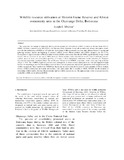Please use this identifier to cite or link to this item:
http://hdl.handle.net/10311/439| Title: | Wildlife resource utilisation at Moremi Game Reserve and Khwai community area in the Okavango Delta, Botswana |
| Authors: | Mbaiwa, J.E. |
| Keywords: | Wildlife resources Resource conflicts Sustainable development Community-based natural resource management |
| Issue Date: | 2005 |
| Publisher: | Elsevier http://www.doi:10.1016/j.jenvman.2005.03.007 |
| Citation: | Mbaiwa, J.E. (2005) Wildlife resource utilisation at Moremi Game Reserve and Khwai community area in the Okavango Delta, Botswana, Journal of Environmental Management, Vol. 77, pp. 144- 156. |
| Abstract: | This paper uses the concept of sustainable development to examine the utilisation of wildlife resources at Moremi Game Reserve (MGR) and Khwai community area (NG 18/19) in the Okavango Delta, Botswana. Using both secondary and primary data sources, results show that the establishment of MGR in 1963 led to the displacement of Khwai residents from their land; affected Basarwa’s hunting and gathering economy; marked the beginning of resource conflicts between Khwai residents and wildlife managers; and, led to the development of negative attitudes of Khwai residents towards wildlife conservation. Since the late 1980s, a predominately foreign owned tourism industry developed in and around MGR, however, Khwai residents derive insignificant benefits from it and hence resource conflicts increased. In an attempt to address problems of resource conflicts and promote sustainable wildlife utilisation, the Botswana Government adopted the Community-Based Natural Resource Management (CBNRM) programme, which started operating at Khwai village in 2000. The CBNRM programme promotes local participation in natural resource management and rural development through tourism. It is beginning to have benefits to Khwai residents such as income generation, employment opportunities and local participation in wildlife management. These benefits from CBNRM are thus having an impact in the development of positive attitudes of Khwai residents towards wildlife conservation and tourism development. This paper argues that if extended to MGR, CBNRM has the potential of minimising wildlife conflicts between Khwai residents and the wildlife-tourism sectors. This approach may in the process promote the sustainable wildlife use in and around MGR. |
| URI: | http://hdl.handle.net/10311/439 |
| ISSN: | 0301 4797 |
| Appears in Collections: | Research articles (Dept of Environmental Science) |
Files in This Item:
| File | Description | Size | Format | |
|---|---|---|---|---|
| Mbaiwa_JEM_2005.pdf | Main article | 1.99 MB | Adobe PDF |  View/Open |
Items in DSpace are protected by copyright, with all rights reserved, unless otherwise indicated.
